
Post-Impressionism-III
Marie Bracquemond
1840 – 1916

Marie Bracquemond (1 December 1840 – 17 January 1916) was a French Impressionist artist. She was one of four notable women in the Impressionist movement, along with Mary Cassatt (1844-1926), Berthe Morisot (1841-1895), and Eva Gonzales (1847-1883). Bracquemond studied drawing as a child and began showing her work at the Paris Salon when she was still an adolescent. She never underwent formal art training, but she received limited instruction from Jean-Auguste-Dominique Ingres (1780–1867) and advice from Paul Gauguin (1848–1903) which contributed to her stylistic approach.
She married noted printmaker Félix Bracquemond (1833–1914), who helped popularize Japanese art in France. Together, they produced ceramic art for Haviland & Co., a manufacturer of Limoges porcelain. Marie's frequent omission from books on artists is sometimes attributed to the efforts of her husband. Although Félix participated with the Impressionist exhibitions, he notably disapproved of the movement at which his wife excelled. Indeed, Pierre Bracquemond, their son, stated that his father was jealous of Marie's work, belittled her ambition, and refused to show her paintings to visitors.

On the Terrace at Sevres
1880

Afternoon Tea
1880

Portrait of mademoiselle Charlotte du Val d Ognes

Louise in the Garden

The Artist’s Son and Sister in the Garden at Sevres
1890
Federico Zandomeneghi
1841 - 1917

Federico Zandomeneghi
Zandomeneghi Federico (b Venice, 2 June 1841; d Paris, 30 Dec 1917). Italian painter. His father Pietro and grandfather Luigi tried to interest him in the plastic arts, but from a very early age he showed a stronger inclination for painting. Zandomeneghi soon rebelled against their teachings, and by 1856 he was attending the Accademia di Belle Arti in Venice, studying under the painters Michelangelo Grigoletti (1801–70) and Pompeo Molmenti (1819–94). As a Venetian he was born an Austrian subject, and, to escape conscription, he fled his city in 1859 and went to Pavia, where he enrolled at the university. In the following year he followed Garibaldi in the Expedition of the Thousand; afterwards, having been convicted of desertion and therefore unable to return to Venice, he went to Florence, where he remained from 1862 to 1866. This period was essential for his artistic development. In Tuscany he frequented the Florentine painters known as the Macchiaioli, with some of whom he took part in the Third Italian War of Independence (1866). Zandomeneghi formed a strong friendship with Telemaco Signorini and Diego Martelli, with whom he corresponded frequently for the rest of his life. In this period he painted the Palazzo Pretorio of Florence (1865; Venice, Ca’ Pesaro), in which the building, represented in the historical–romantic tradition, is redeemed by a remarkable sense of air and light, elements derived from the Macchiaioli.

Zandomeneghi Federico - Femme qui s'etire

Zandomeneghi Federico - Le the

Zandomeneghi Federico - Donna che si asciuga
.jpg)
Zandomeneghi Federico - Le reveil

Zandomeneghi Federico - Place du Tertre a Parigi
Lilla Cabot Perry
1848 – 1933

Lilla Cabot Perry
(born Lydia Cabot; January 13, 1848 – February 28, 1933) was an American artist who worked in the American Impressionist style, rendering portraits and landscapes in the free form manner of her mentor, Claude Monet. Perry was an early advocate of the French Impressionist style and contributed to its reception in the United States. Perry's early work was shaped by her exposure to the Boston School of artists and her travels in Europe and Japan. She was also greatly influenced by Ralph Waldo Emerson's philosophies and her friendship with Camille Pissarro. Although it was not until the age of thirty-six that Perry received formal training, her work with artists of the Impressionist, Realist, Symbolist, and German Social Realist movements greatly affected the style of her oeuvre.
Self Portrait

Child at the Window (Edith Perry)

La Petite Angèle, II, 1889

In a Japanese Garden, 1898-1901

Lady with a Bowl of Violets, 1910

A Snowy Monday, 1926

The Black Hat, 1914

The Beginner, 1885

Open Air Concert

The Trio (Alice, Edith, and, Margaret Perry)

A Cup of Tea

The Cellist

Lady in an Evening Dress

The Pink Rose

Reading

Portrait of Julia Sullivan Lynch
Jean-Louis Forain
1852 – 1931
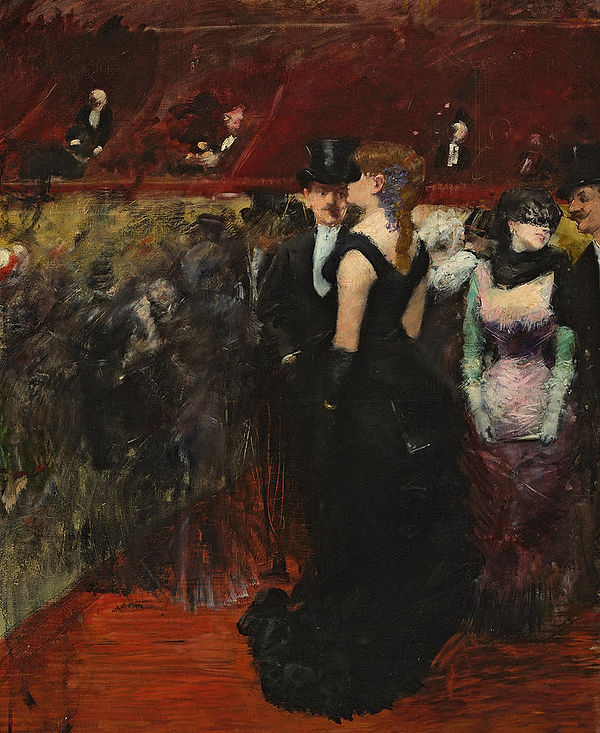
A Ball at the Paris Grand Opera, by Jean-Louis Forain

Photograph of Jean-Louis Forain and Jeanne Bosc in a Venetian Gondola
Jean-Louis Forain
(23 October 1852 – 11 July 1931) was a French Impressionist painter and printmaker, working in media including oils, watercolour, pastel, etching and lithograph. Compared to many of his Impressionist colleagues, he was more successful during his lifetime, but his reputation is now much less exalted.
Forain was born in Reims, Marne but at age eight, his family moved to Paris. He began his career working as a caricaturist for several Paris journals including Le Monde Parisien and Le rire satirique. Wanting to expand his horizons, he enrolled at the École des Beaux Arts, studying under Jean-Léon Gérôme as well as another sculptor/painter, Jean-Baptiste Carpeaux.
Forain's quick and often biting wit allowed him to befriend poets Arthur Rimbaud and Paul Verlaine as well as many writers, most notably Joris-Karl Huysmans. He was one of only "seven known recipients" to receive a first edition of A Season in Hell directly from Rimbaud. He was the youngest artist to frequent and participate in the feverish debates led by Édouard Manet and Edgar Degas at the Café de la Nouvelle Athènes in Montmartre.
A follower and protégé of Degas, Forain joined the Impressionist circle in time to take part in the fourth independent exhibition in 1879; he participated in four of the eight Impressionist Exhibitions (1879, 1880, 1881 and 1886). Influenced by Impressionist theories on light and color, he depicted scenes of everyday life: his watercolors, pastels and paintings focused on Parisian popular entertainments and themes of modernity—the racetrack, the ballet, the comic opera and bustling cafés.
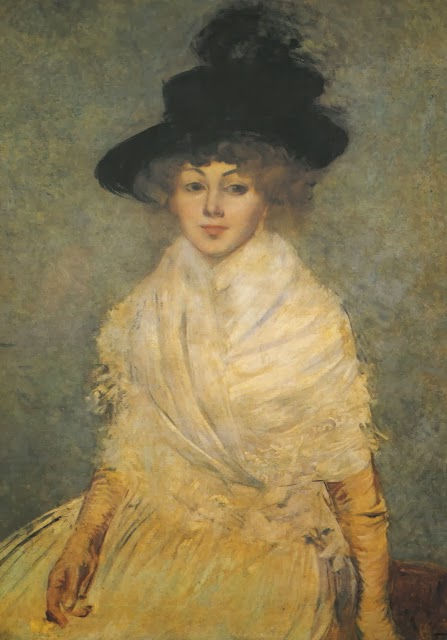
Jean-Louis Forain depicting his wife, the painter Jeanne Forain (nee Jeanne Bosc), wearing a black hat

Les ballerines by Jean Louis Forain

Danseuses dans les coulisses à l’opéra by Jean Louis Forain

Pierrot et la danseuse by Jean Louis Forain

Elegantes in Cafe by Jean Louis Forain

The Place Clichy, Paris by Jean-Louis Forain, 1883-84
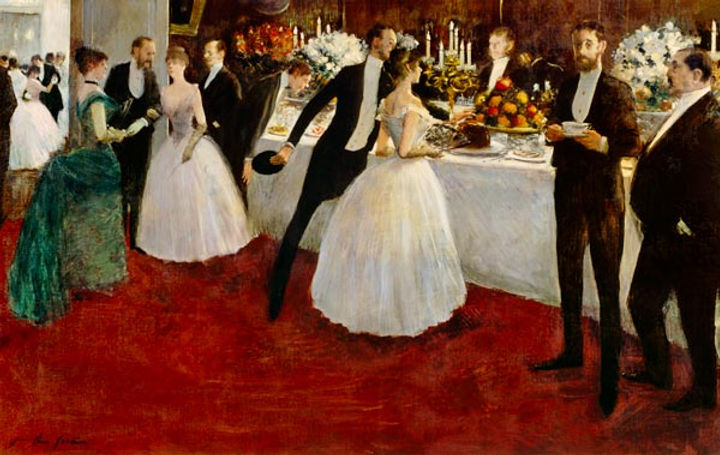
The Buffet, 1884 by Jean Louis Forain

The Prom Notebook, c 1888 by Jean Louis Forain
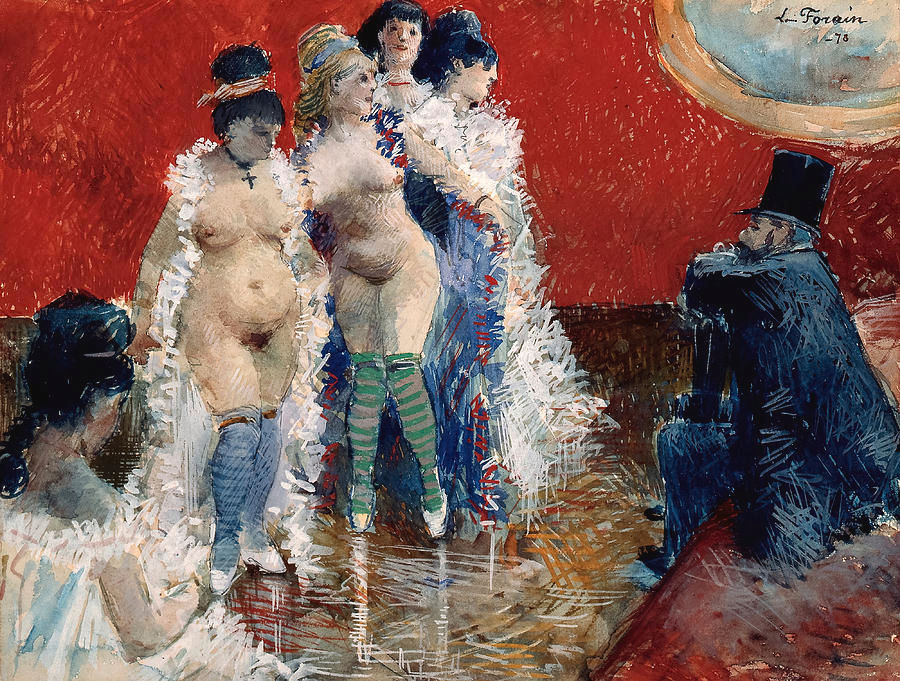
The Client, by Jean-Louis Forain

Dancer on Her Knees by Jean-Louis Forain

Nude by Jean Louis Forain

Leaving the Masquerade Ball at the Grand Opera by Jean-Louis Forain
John Lavery
1856 – 1941
Sir John Lavery
(20 March 1856 – 10 January 1941) was an Irish painter best known for his portraits and wartime depictions.
John Lavery was born in inner North Belfast, baptised at St Patrick's Church, Belfast and, while still a child, moved to Scotland where he attended Haldane Academy in Glasgow in the 1870s. In 1878 he set up his own studio which was razed in a fire in the following year. With a £300 insurance pay-out he spent a year studying at Heatherley's School in London. Lavery continued his studies at the Académie Julian in Paris in the early 1880s. He returned to Glasgow and was associated with the Glasgow School. William Burrell, a wealthy shipowner, was a faithful patron of Scottish artists including Joseph Crawhall II, with whom Lavery studied. In 1888 he was commissioned to paint the state visit of Queen Victoria to the Glasgow International Exhibition. This launched his career as a society painter and he moved to London soon after. In 1896, William Burrell commissioned Lavery to paint a portrait of his sister Mary Burrell.
In his memoir, Lavery acknowledged Burrell's patronage. In London, he became friendly with James McNeill Whistler and was clearly influenced by him.
Like William Orpen, Lavery was appointed an official artist in the First World War. Ill health, however, prevented him from travelling to the Western Front. A serious car crash during a Zeppelin bombing raid also kept him from fulfilling this role as war artist. He remained in Britain and mostly painted boats, aeroplanes and airships. During the war years he was a close friend of the Asquith family and spent time with them at their Sutton Courtenay Thames-side residence, painting their portraits and idyllic pictures like Summer on the River (Hugh Lane Gallery).

Sir John Lavery Self Portrait, 1928

Sir John Lavery - Evelyn Farquhar, wife of Captain Francis Douglas Farquhar

Sir John Lavery - Portrait of Miss Mary Burrell, 1896

Sir John Lavery - The Red Rose, 1923

Sir John Lavery - Woman with golden turban, Hazel Lavery née Hazel Martyn

Sir John Lavery - Hazel in rose and grey

Sir John Lavery - A Rally, 1885

Sir John Lavery - Lady Lavery

Sir John Lavery - A Summer Afternoon

Sir John Lavery - Mrs Ralph Peto as a Bacchante

Sir John Lavery - Portrait of Mrs Burrell

Sir John Lavery - The Chess Players, 1929

Sir John Lavery - The Mother, 1909

Sir John Lavery - The Green Coat

Sir John Lavery - Daylight raid from my studio window 1917
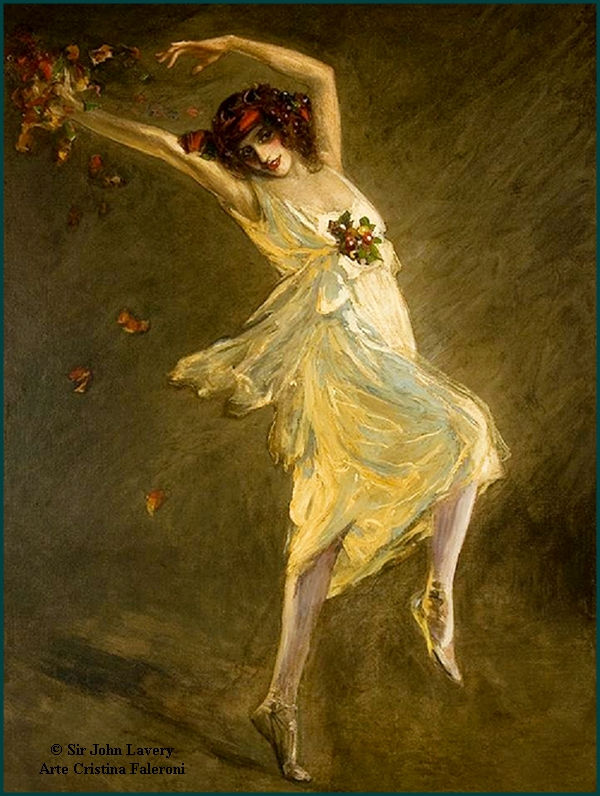
Sir John Lavery - Anna Pavlova (1911)

Sir John Lavery - Anna Pavlova (1911)
Henri-Edmond Cross
1856 – 1910
Henri-Edmond Cross (20 May 1856 – 16 May 1910), born Henri-Edmond-Joseph Delacroix (French pronunciation: [ɑ̃ʁi ɛdmɔ̃ ʒozɛf dəlakʁwa]), was a French painter and printmaker. He is most acclaimed as a master of Neo-Impressionism and he played an important role in shaping the second phase of that movement. He was a significant influence on Henri Matisse and many other artists. His work was instrumental in the development of Fauvism.

Henri-Edmond-Cross-Self-portrait

Henri-Edmond Cross - L'air du soir, c. 1893

Henri-Edmond Cross - La Plage de Saint-Clair, 1896

Henri-Edmond Cross - La fuite des nymphes, c. 1906

Henri-Edmond Cross - Cypresses at Cagnes, 1908

Henri-Edmond Cross - Dormeuse nue dans la clairière, 1907
Walter Richard Sickert
1860 – 1942

Walter Richard Sickert (31 May 1860 – 22 January 1942) was a German-born British painter and printmaker who was a member of the Camden Town Group of Post-Impressionist artists in early 20th-century London. He was an important influence on distinctively British styles of avant-garde art in the mid and late 20th century.
Sickert was a cosmopolitan and eccentric who often favoured ordinary people and urban scenes as his subjects. His work includes portraits of well-known personalities and images derived from press photographs. He is considered a prominent figure in the transition from Impressionism to Modernism. Decades after his death, several researchers and theorists suspected Sickert to have been the London-based serial killer Jack the Ripper, but the theory has largely been dismissed.
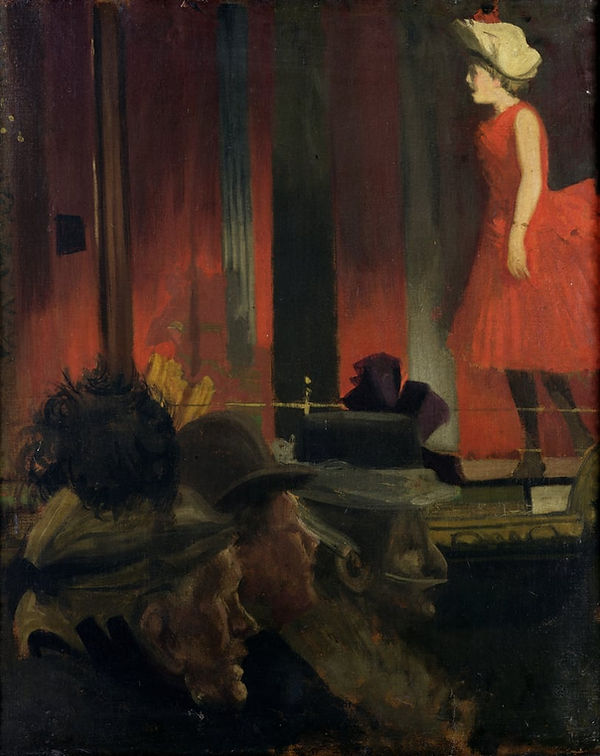
Walter Sickert. The Music Hall, 1889

Ennui, 1917-18, Walter Sickert

La Hollandaise, 1906, Walter Sickert

Variation on Peggy, Walter Sickert, 1934-35

The Lady with a Lamp', about 1932–34, Walter Sickert

Reclining Nude by Sickert, Walter Richard

The Blackbird of Paradise, Walter Sickert

Home Life, Camden Town, Walter Sickert

Mornington Crescent Nude, c.1907, Walter Sickert

The Little Old Bedford, Walter Sickert

High-Steppers, 1938-1939, by Walter Richard Sickert

Reclining Nude Thin Adeline, Walter Sickert

The System, 1924-1926, by Walter Sickert

Interior With Nude 1914 , Walter Sickert

The Studio: The Painting of a Nude, 1906, Walter Sickert

The Camden Town Murder or What Shall We Do about the Rent? c.1908, Walter Sickert

L'Affaire de Camden Town, Walter Sickert
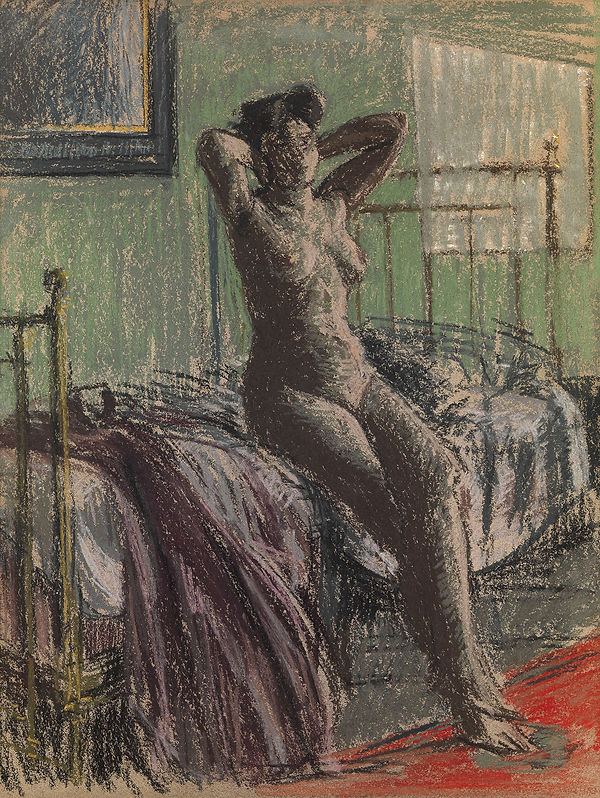
Nude Stretching: La Coiffure, Walter Sickert

Mornington Crescent nude, contre-jour, Walter Sickert

Ennui, 1917-18, Walter Sickert. Self-portrait

Walter Richard Sickert, The Iron Bedstead (ca. 1906)

Nude, Walter Sickert

Minnie Cunningham at the Old Bedford, Walter Sickert

Café Suisse, Dieppe
1914

Mrs Swinton, Walter Sickert
Philip Wilson Steer
1860 – 1942

Philip Wilson Steer (28 December 1860 – 18 March 1942) was a British painter of landscapes, seascapes plus portraits and figure studies. He was also an influential art teacher. His sea and landscape paintings made him a leading figure in the Impressionist movement in Britain but in time he turned to a more traditional English style, clearly influenced by both John Constable and J. M. W. Turner, and spent more time painting in the countryside rather than on the coast. As a painting tutor at the Slade School of Art for many years he influenced generations of young artists.

The Bridge (1887)

Girls Running: Walberswick Pier

Philip Wilson Steer. Boulogne Sands

Philip Wilson Steer. Sleep

Philip Wilson Steer. Seated Nude: The Black Hat

Philip Wilson Steer. The Music Room

Philip Wilson Steer. Model Seated Before a Mirror

Philip Wilson Steer. Hydrangeas